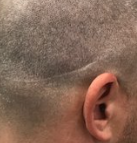Hello,
I am a 21 year old male and for the last year or so I have began to notice that my hairline is receding. In an attempt to control my hair loss I have purchased Procerin and minoxidil 5% and I am considering going to my doctor to ask for his opinion on using Propecia. I have also been reading up on the subject of hair transplants but have came to understand that I am too young to consider this sort of option. However, this brings me to my questions:
- If I add Propecia to my current regime (Minox, Procerin) will my doctor or dermatologist still be able to map my hair loss and estimate when it would be wise to consider a hair transplant?
- Or will I have to stop my regime, for a period of time, to allow the regrown (if there is any) hair to fall out, thus allowing my doctor to see the natural recession of my hair line?
- Or would I have to stay on a course of Propecia forever, so to stop any hair loss behind the hair transplant?
I am answering your questions in the order you asked:
- The available FDA approved medications for hair loss can help slowing down or in some occasions stopping the process of hair loss. Early 20s is the period that most physicians don’t want to rush into performing a hair transplant, because it is hard to predict the progress of the hair loss and final hair loss pattern at this age. Considering the family history of baldness, hair loss medication use and degree of miniaturization can help establish a Master Plan for a young patient like you. So, you need to find a good doctor for a thorough evaluation and only after considering all above factors should atime table be tailored for your hair transplants.
- The effect of these medications on your hair growth is gradual and I don’t recommend stopping them to find out your natural degree of hair loss. You will end up losing more hair unnecessarily by doing that. I have no information about Porcerin, but Propecia is the most appropriate medication to control progression of genetic hair loss in young men.
- I recommend that you develop a Master Plan for the treatment and stick to it, being monitored with yearly miniaturization studies to follow the progression of the hair loss. Most of the patients need to continue their treatment for the rest of their lives, so it is wise to do your research before starting such treatments.


